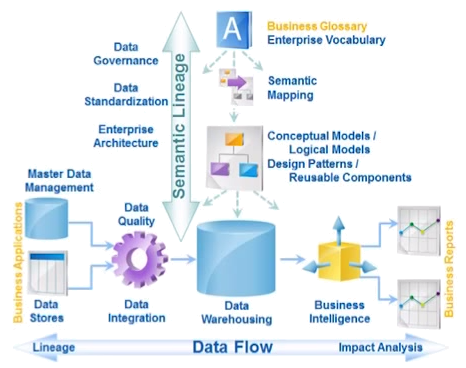The concept and discipline of data governance has grown in importance as organizations are forced to comply with regulations, cut costs, integrate among different COTS (Commercial-off-the-shelf) systems, provide data interoperability through internal and external APIs.
One of my retail clients has large daily transaction data flow among retail, wholesale inventory, financial, auditing and warehouse departments, etc. It has separate COTS systems such as JDA ESO, eCommerce Shopify and Tecsys SCM, etc. It also has in-house store master, product master data, etc. In some system, SKU is defined as 6-digits number; in another, it’s defined as varchar. In such a complex environment, data management turns to be an outstanding issue.
In order to improve customer experience, increase efficiency, establish enterprise-level data ownership and stewardship, to implement a data governance program is necessary. Similar to building up Enterprise Architecture Program steps outlined in EA Program: The Key to the Success in your Digital Strategy, we need define data governance strategies, scopes and have data governance bodies to apply these strategies:

Step 1: Define data governance strategies and scopes. Establish your vision that supports your business goals, determine your priority and focus.
Step 2: Establish data governance groups:
- Data Governance Steering Committee (DGSC): Sets vision
- Data Governance Office (DGO): Implements vision and enforces policies
- Data Governance Stewards (DGS): for execution and implementation.
Step 3: Define and collect policies and rules. Understand regulations and data interoperability needs;
Step 4: Understand processes and procedures. Understand data flow, work flow, input / output and data processing procedures;
Step 5: Collaboration. Since data governance groups are composed of cross-functional teams, collaboration among them are the key to success. A good data model is built based on the common efforts of Business Data Steward / Analyst and Data Architect, and it’s verified by Data Quality Lead / QA.
Step 6: Utilizing software tools in master data management (MDM) , data modeling, work flow management, data quality and analytics; To define a complete Business Glossary (enterprise master data) relies on the efforts of DGS group, industry experts and business analysts. An effective way is to build up an intranet Wiki which allows authorized individuals to add, delete and update items, and these items can be referenced by Data Architect in data modeling design. There are lots of free Wiki products available, such as MediaWiki, DokuWiki, etc. An industry taxonomy can be a good reference to build up your Business Glossary. In above Data Governance Diagram, most organization start from building data model and skip Business Glossary and Semantic Mapping steps – which is what we need to make up through data governance program.
Step 7: Audit, Metrics and Security. This is to monitor data integrity, data validation, report issues and evaluate troubleshooting efforts. This is also for applying authentication and authorization to systems for managing data access.
Lionsgate Software has rich experience in data governance, data modeling design, data analytics. For data modeling guidance, please access 10 Best Practices in Database Schema Design and Database Modeling in UML. Should you have any questions, please do not hesitate to contact us.


